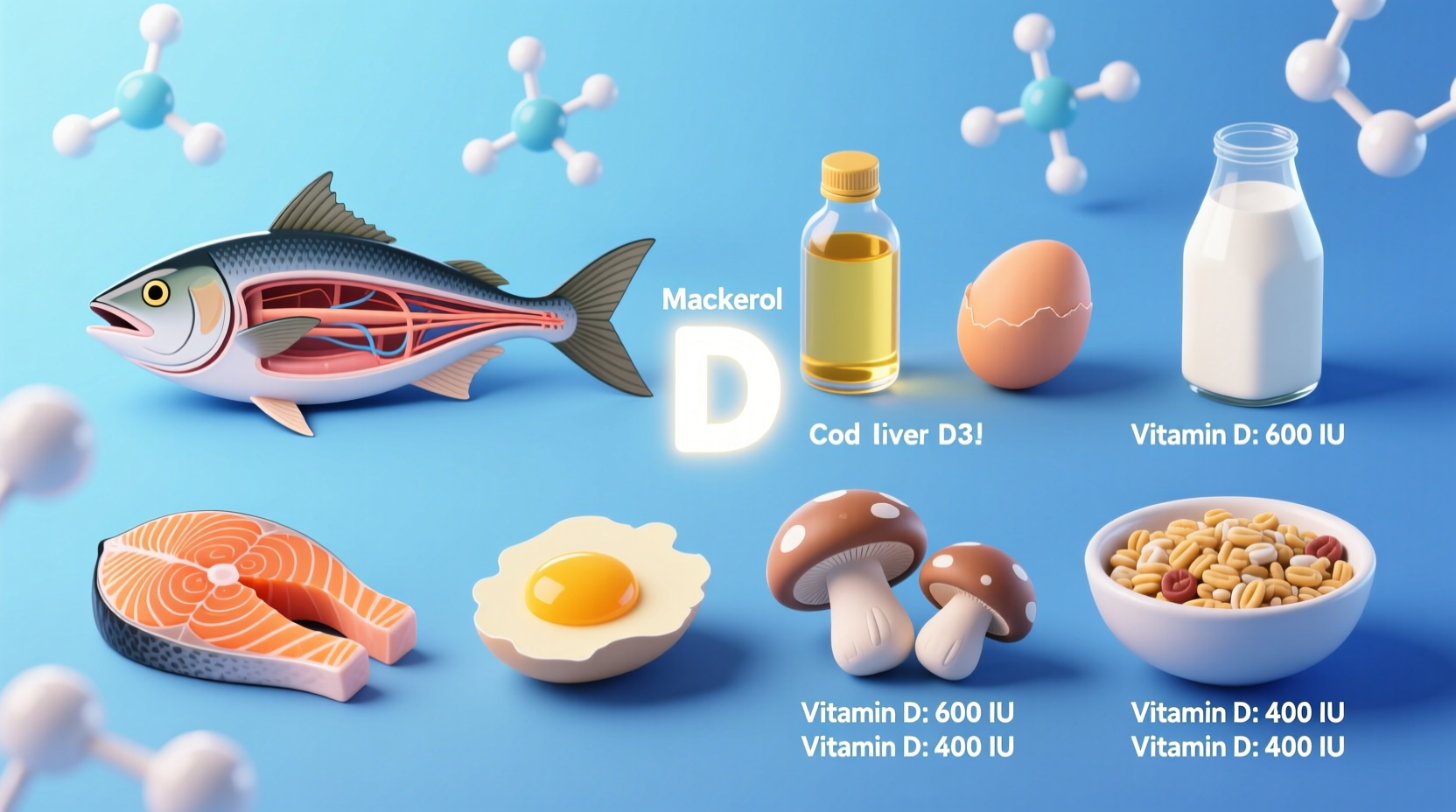Understanding which foods contain significant vitamin d levels is crucial for maintaining optimal health, especially for those with limited sun exposure or dietary restrictions. Vitamin d deficiency affects nearly 1 billion people worldwide, making dietary sources increasingly important for supporting calcium absorption, immune function, and cellular health.
Vitamin D Powerhouse Foods: Natural Sources and Fortified Options
When building a vitamin d-rich diet, focus on these scientifically validated food sources that deliver substantial amounts per serving. The National Institutes of Health recommends adults aged 19-70 consume 600 IU (15 mcg) daily, while those over 70 need 800 IU (20 mcg).
| Food Source | Serving Size | Vitamin D (IU) | % Daily Value |
|---|---|---|---|
| Cod liver oil | 1 tablespoon | 1,360 | 170% |
| Wild-caught salmon | 3 ounces | 570 | 71% |
| Fortified orange juice | 1 cup | 137 | 17% |
| UV-exposed mushrooms | 3 ounces | 2,300 | 288% |
| Fortified milk (cow's) | 1 cup | 120 | 15% |
Data sourced from the NIH Office of Dietary Supplements and USDA FoodData Central shows significant variation in vitamin d content based on preparation methods and sourcing. Wild-caught fish typically contain 2-3 times more vitamin d than farm-raised varieties due to their natural diet.

Maximizing Vitamin D Absorption from Food Sources
Vitamin d is fat-soluble, meaning your body absorbs it best when consumed with dietary fats. Pairing vitamin d-rich foods with healthy fats dramatically increases bioavailability:
- Combine fortified milk with full-fat yogurt rather than non-fat versions
- Add olive oil to sautéed vitamin d mushrooms
- Eat salmon with avocado for enhanced absorption
- Avoid low-fat preparations when consuming vitamin d fortified foods
Research published in the American Journal of Clinical Nutrition confirms that consuming vitamin d with a fat-containing meal increases absorption by up to 32% compared to fat-free preparations. This explains why traditional preparations like cod liver oil (naturally high in fats) remain among the most effective dietary sources.
Practical Integration into Daily Meals
Building a vitamin d-rich diet doesn't require drastic changes. Implement these simple strategies:
Morning Boost
Start your day with fortified milk in your coffee or cereal, plus two egg yolks cooked in olive oil. This combination provides approximately 200 IU of vitamin d to kickstart your daily intake.
Lunch Solutions
Choose canned sardines or mackerel on whole grain bread instead of typical lunch options. A single serving of canned mackerel delivers over 400 IU, meeting nearly 70% of your daily requirement.
Dinner Focus
Incorporate wild-caught salmon twice weekly as your primary protein source. Pair with UV-exposed mushrooms sautéed in coconut oil for a vitamin d powerhouse meal exceeding 700 IU.
Contextual Considerations for Vitamin D Intake
While food sources are valuable, certain situations require additional considerations:
- Geographic limitations: People living above 37° latitude may receive insufficient UVB radiation October through March, making dietary sources critical during these months
- Aging population: Skin's ability to synthesize vitamin d decreases by 75% between ages 20-80, increasing dietary needs
- Dark-skinned individuals: Higher melanin levels reduce vitamin d synthesis by up to 90%, requiring greater dietary attention
- Medical conditions: Those with Crohn's, celiac, or liver disease often require supplementation despite adequate dietary intake
The Endocrine Society notes that food sources alone typically provide only 10-20% of daily vitamin d requirements for most people. This explains why fortification practices evolved significantly since the 1930s when rickets was epidemic in industrialized cities. Today's fortified milk, cereals, and juices represent public health solutions to widespread deficiency.
When Food Sources Aren't Enough
Dietary vitamin d has limitations that many consumers don't recognize. While salmon provides excellent amounts, you'd need to eat 5-7 ounces daily to reach recommended levels without other sources. For most people, a combination approach works best:
- Morning: Fortified milk or orange juice (100-130 IU)
- Lunch: Fortified cereal with milk (150 IU)
- Dinner: 3 oz salmon (450 IU)
- Total: Approximately 700 IU
This still falls short of optimal levels for many individuals, particularly during winter months. Consult your healthcare provider about potential supplementation needs, especially if you have limited sun exposure, darker skin, or digestive conditions affecting nutrient absorption.
Key Takeaways for Vitamin D Optimization
Building sufficient vitamin d levels requires strategic dietary choices combined with awareness of personal factors. Prioritize wild-caught fatty fish, fortified dairy alternatives, and UV-exposed mushrooms while consuming these foods with healthy fats for maximum absorption. Remember that food sources typically provide only part of your daily requirement, so discuss your individual needs with a healthcare professional.











 浙公网安备
33010002000092号
浙公网安备
33010002000092号 浙B2-20120091-4
浙B2-20120091-4